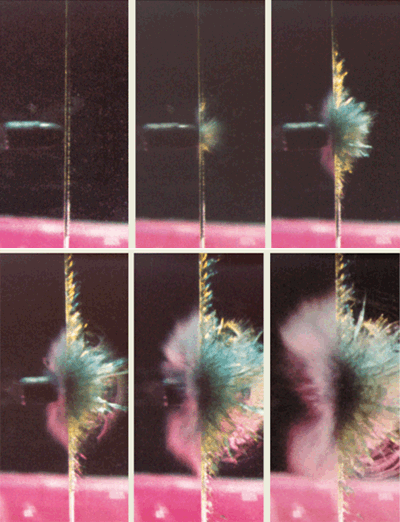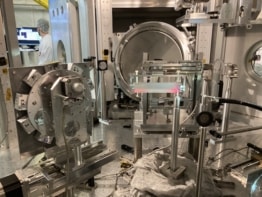Manufacturers of high-speed cameras are exploiting advances in electronics and optical design to photograph a wide range of physics processes on ever-decreasing timescales.

According to the old adage, “a picture paints a thousand words”. And in many scientific disciplines ultrahigh-speed imaging is the only reliable way to visualize the countless physical and mechanical processes that occur on microsecond timescales. Such processes include ballistics, the propagation of cracks in materials, flame fronts in combustion research, the generation of shock waves in aircraft components and electrical “streamers” in high-voltage research.
Conventional cameras – devices that record images onto photographic film – are at least a hundred times slower than electronic cameras, which can capture up to 600 million images per second. The rate for conventional cameras is limited because the film has to be accelerated to very high speeds through the camera, which is a major obstacle when recording microsecond events. And mechanical failures are not unknown.
In contrast, electronic cameras have no moving parts and can have high sensitivity, making them ideal for recording faint ultrafast processes. Moreover, the resulting digital images can be analysed in far greater detail than conventional photographic prints. So how do electronic cameras work?
In the picture
Light entering the camera is focused onto an image-intensifier photocathode, which releases electrons in proportion to the number of incident photons. These electrons are then accelerated towards a device called a microchannel plate, where they produce an avalanche of electrons via collisions. From the microchannel plate, the electrons are further accelerated towards a phosphor screen where a more intense copy of the original event is created and then transferred via a fibre-optic link to a charge-coupled device (CCD) that records the image.
Indeed, it is this ability to multiply the number of generated photoelectrons that makes it possible to photograph very faint objects at high speeds. With a conventional camera, we either have to increase the exposure time of the camera and risk blurring the image, or dramatically increase the light illuminating the object, which is often undesirable or even impossible.
In general, physicists and engineers demand ever-increasing spatial and temporal resolution from each successive generation of high-speed camera. But it would be prohibitively expensive to build a single camera that would satisfy every application and every scientist’s needs, so compromises must therefore be made. The latest cameras exploit a simple optical trick and improvements in CCD technology to increase the spatial and temporal resolution.
An example of one such camera is the Imacon 200 made by my company DRS Hadland in the UK. It can record up to 200 million images very second with eight CCDs that are coupled to a novel pyramid-shaped beamsplitter. This beamsplitter was first proposed during the 1950s by Courtney Pratt, then at Cambridge University in the UK, and co-workers. However, the device was never produced because it was too laborious and expensive to develop using the technology available to optical designers at the time. Modern computers and rare-earth glasses have revolutionized the design of optical components and the pyramid scheme for the Imacon 200 was completed in a relatively short time.
As its name suggests, the pyramid beamsplitter is a block of glass with eight facets, each of which acts as a highly reflective triangular-shaped mirror. The light from each surface (about 12% of the total incoming light) is reflected towards steering mirrors, which direct each beam towards eight intensified CCD-based sensors. By carefully controlling the read-out time of each CCD, we can increase the temporal resolution relative to that of a camera with only one detector without spoiling the quality of the image. Indeed, cameras that have an electron multiplier between the photocathode and the phosphor screen allow faint images to be recorded while keeping exposure times as short as 5 nanoseconds.
One area that benefits greatly from such high sensitivity is combustion research into environmentally friendly “lean-burn” car engines. The flame front produced immediately after ignition is extremely faint and difficult to record in detail with many cameras. However, this problem can be readily overcome by increasing the camera sensitivity. Meanwhile, the chemical differences between burned and unburned fuel can be investigated by inserting narrow-band-pass filters into the individual optical paths of the eight beams.
Racing ahead
Another advantage of electronic cameras is that they can record discrete frames and continuous “streak” images at the same time. While individual frames show an object in detail, information is inevitably lost during the “dead time” between successive images. Streak images provide a continuous visual record of spatial resolution plotted against time and are particularly useful in applications such as plasma and explosives research.
Camera manufacturers have to respond to the economic concerns of laboratories by using technology in an ingenious way to reduce costs. Our company has developed an ultrahigh-speed camera that is cheaper than the Imacon 200 because it uses a single high-resolution CCD. The camera gives good results but, like all things in life, you get what you pay for.
Light entering the device is split into four beams by four mirrors that are arranged to form a square tunnel with reflective inner surfaces. Each of the four images hits a single photocathode that has been segmented into quadrants that can be controlled independently. This separate “gating” allows the exposure time of each quadrant to be varied during the exposure. It also effectively increases the speed of the camera to 100 million frames per second.
The generated photoelectrons are multiplied in a microchannel plate and accelerated towards a phosphor screen. The intensified image is then coupled via an optical fibre to a single CCD with 2000 x 2000 pixels. Each pixel in the CCD generates electrons when it is exposed to light. The charge on each pixel has to be moved into the memory before the incoming light intensity changes and new electrons are generated. This movement of charge takes time, and essentially limits the speed with which the camera can operate. To reduce this problem and speed up the process, fewer pixels are used to produce the image. Indeed, we judiciously masked all but every 17th pixel in each column of the CCD to the incoming light. The electrons are moved to the masked pixels, which act as a temporary store for charge before the recorded sequence of images is downloaded to permanent memory. The process takes some 5 microseconds, which limits the speed of the camera to 350 000 frames per second – which is still good enough for many materials-research projects.
Ultimately, all high-speed cameras are a compromise as it is impossible to include every desirable feature in a single instrument and, invariably, the type of research dictates the choice of camera. Where long recording times are essential, conventional film cameras have an advantage, although it is more difficult to extract useful data from the analogue images recorded on film. Similarly, some of the latest high-speed video cameras offer reasonably long recording times, but the resolution is sacrificed because fewer pixels on the sensor are used. Electronic cameras have a shorter recording window but are flexible and can be synchronized to ultrafast events.
The choice of camera clearly depends on what picture you want to paint!



